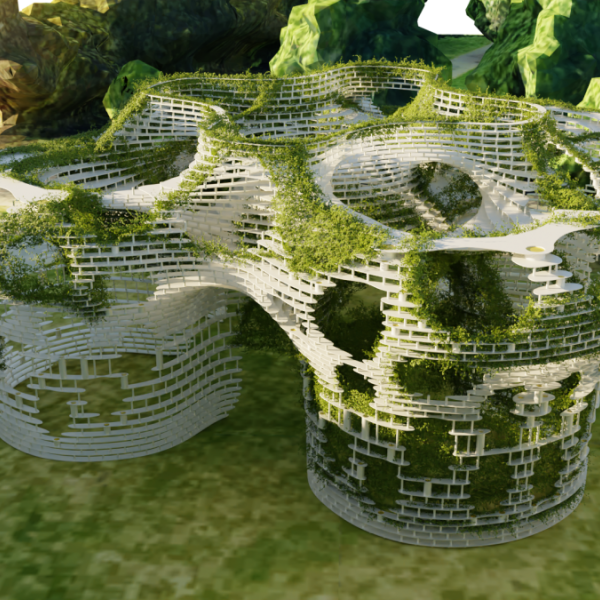Comparison Genius Loci & Zeitgeist
While "genius loci" refers to the spirit or unique character of a specific place, "zeitgeist" refers to the spirit or mindset characteristic of a particular period. Genius loci is more focused on a spatial context, whereas zeitgeist is temporal, capturing the overall feel of a specific era. The genius loci was considered important in Roman religion, where even households had their protective spirits or genii. Over time, this concept was embraced in various fields, including literature, architecture, and landscape design, to describe the unique atmosphere or spirit of a place.
"Zeitgeist" is a German term that translates to "spirit of the age" or "spirit of the times." It refers to the cultural, intellectual, ethical, and political climate, ambiance, and ethos of an era. The concept is often used to describe the prevailing set of ideas and beliefs that shape the behaviors and attitudes of a society during a particular period.
In German philosophy, the term is particularly associated with the works of Georg Wilhelm Friedrich Hegel. Hegel (1770-1831) was a prominent German philosopher whose ideas have had a profound impact on a wide range of fields, including philosophy, history, politics, and theology.
Hegel's Use of "Zeitgeist"
1.Historical Development: Hegel believed that history unfolds in a rational process, which he described as the unfolding of the "World Spirit" (Weltgeist). According to Hegel, “Zeitgeist” is the manifestation of the World Spirit at a particular point in time, and each historical epoch has its own unique spirit that shapes the ideas, culture and institutions of that time.
2.Dialectical Process: Hegel's philosophy is known for its dialectical method, which involves the resolution of contradictions through a process of thesis, antithesis, and synthesis. The "Zeitgeist" plays a role in this dialectical process, as the spirit of the age often contains internal contradictions that drive historical change and development.
3.Collective Consciousness: For Hegel, the "Zeitgeist" is not just an abstract concept but is embodied in the collective consciousness of a people. It influences and is influenced by the actions, thoughts, and creations of individuals and institutions within a society.
4.Progress and Freedom: Hegel saw history as a rational process that moves toward greater freedom and self-awareness. The "Zeitgeist" at any given time reflects the level of freedom and self-consciousness that society has achieved. Changes in the "Zeitgeist" are thus seen as part of the broader historical progression toward human freedom.
Influence and Legacy
Hegel's concept of the "Zeitgeist" has had a lasting impact on various fields:
1. Philosophy of History: Hegel's idea that history has an inherent rational structure and direction has influenced many subsequent philosophers and historians.
2. Sociology and Cultural Studies: The concept of the "Zeitgeist" is used to analyze the prevailing cultural and social norms of different historical periods.
3. Political Theory: Hegel's ideas about the dialectical process and the role of the "Zeitgeist" in historical development have influenced political theorists, particularly those concerned with the dynamics of social change.
In the context of German philosophy, particularly the works of Georg Wilhelm Friedrich Hegel, the concept of Zeitgeist plays a significant role. Hegel, a profound philosopher of the early 19th century, believed that the progression of history is not random but follows a rational process. According to Hegel, history is driven by the unfolding of the "World Spirit" (Weltgeist) through the dialectical process, where each era's Zeitgeist reflects the World Spirit's development at that specific stage.
Hegel's dialectical process involves
1. Thesis: An existing idea or state of affairs.
2. Antithesis: The challenge or opposition to the thesis.
3. Synthesis: The resolution that reconciles the thesis and antithesis, leading to a higher level of understanding.
This synthesis then becomes the new thesis, which will eventually be challenged again, continuing the dialectical process.
For Hegel, each epoch's Zeitgeist is an expression of the World Spirit's self-realization journey. By examining the cultural, political, and intellectual developments of each period, one can understand the progression of human consciousness and freedom. Thus, the Zeitgeist is not static but dynamically evolving, reflecting the ever-changing nature of human society.
In summary, within the realm of German philosophy and Hegel's works, Zeitgeist represents the characteristic spirit of an age that encapsulates the dominant ideas and cultural ethos, contributing to the unfolding and development of human history and consciousness.
Hegel's concept of "Zeitgeist" (the spirit of the times) is integral to his philosophy of history. He elaborates on this idea within his broader metaphysical system, where history is seen as a rational process through which human freedom and consciousness develop over time. A deeper exploration of Hegel's idea about Zeitgeist:
Core Concepts in Hegel’s Philosophy
1. World Spirit (Weltgeist): The World Spirit represents the collective consciousness and rationality that drives the historical process. It is the universal mind or spirit that manifests itself through the progress of history.
2. Dialectical Process: Hegel's dialectical process involves the interaction of opposing forces: thesis, antithesis, and synthesis. These interactions propel historical development and the evolution of ideas.
3. Historical Stages: History unfolds in distinct stages, with each era representing a specific phase in the development of human consciousness and freedom. Each stage has its own unique Zeitgeist, which characterizes the dominant ideas, cultural practices, and social structures of the time.
Zeitgeist
1. Expression of the World Spirit: The Zeitgeist of an era is the manifestation of the World Spirit's stage at that particular moment. It captures the prevailing ideas, values, and beliefs that define the culture, politics, and intellectual life of that period.
2. Temporal Nature: The Zeitgeist is time-bound and evolves as history progresses. What defines one era will differ significantly from another, reflecting the dialectical movement of history.
3. Role of Individuals: Individuals play significant roles in expressing and shaping the Zeitgeist. Figures like great leaders, philosophers, and artists help to articulate and challenge the dominant ideas of their time, often driving the dialectical process forward.
Development Through Conflict
1. Thesis and Antithesis: Each thesis eventually encounters contradictions and challenges antitheses that it cannot fully resolve within its own framework. These conflicts necessitate a new synthesis, leading to the birth of a new Zeitgeist.
2. Synthesis: The resolution of these conflicts results in a higher level of understanding and development, producing a new Zeitgeist that is more advanced than the previous one. This continuous process reflects the World Spirit’s progressive self-realization.
Hegel's View on Progress
1. Idea of Progress: Hegel perceived history as a rational process leading to the progressive realization of human freedom and self-consciousness. Each successive age builds upon the advancements and limitations of the previous ones.
2. Teleological Perspective: Hegel’s historical perspective is teleological, meaning he believed that history has a purpose or end goal.
In essence, Hegel's idea of the Zeitgeist encapsulates the spirit and essence of each historical period, representing the specific stage in the World Spirit's development. Each era's Zeitgeist reflects the cultural, intellectual, and social norms that dominate at that time, contributing to the dialectical process that drives history forward. The concept underscores Hegel's belief in a rational structure to history, where each period advances human freedom and consciousness toward an ultimate realization.
The concept of Zeitgeist, or the "spirit of the age," in architecture refers to the way buildings and architectural styles reflect the cultural, intellectual, and social values of the time in which they are created. Architecture, as a form of art and functional space design, serves as a tangible expression of the prevailing ideas and identity of an era. Here’s how the concept of Zeitgeist manifests in architecture:
Key Elements of Zeitgeist in Architecture
1. Cultural Reflection: Architecture captures the aesthetic preferences, technological advancements, and societal values of its time. For example, the grandiose and ornamental designs of Baroque architecture reflect the wealth and power of 17th-century European aristocracy.
2. Innovation and Technology: The materials and construction techniques available significantly influence architectural styles. For instance, the advent of steel and reinforced concrete in the late 19th and early 20th centuries led to the development of skyscrapers and modernist architecture, embodying the industrial spirit of the age.
3. Social and Political Context: Architecture can express social and political ideologies. The austere and functional style of Brutalism in the mid-20th century, for instance, often reflected a desire for utilitarian egalitarianism and honesty in construction materials and methods.
Examples of Architectural Zeitgeist
1. Classical Architecture (Ancient Greece and Rome): Emphasizes symmetry, proportion, and the use of columns (Doric, Ionic, Corinthian). Reflects the values of order, democracy, and the humanistic ideals of ancient civilizations.
2. Gothic Architecture (Middle Ages): Characterized by pointed arches, ribbed vaults, and flying buttresses. Reflects the medieval period's religious fervor, aiming to inspire awe and reach towards the heavens.
3. Renaissance Architecture (15th-17th Century): Revival of classical principles, emphasizing harmony, clarity, and proportion. Reflects the humanism and rediscovery of classical knowledge during the Renaissance period.
4. Baroque Architecture (17th-18th Century): Grand, dynamic, and ornate designs with curves and bold contrasts. Reflects the power, control, and grandeur of the church and state during this period.
5. Modernist Architecture (Early 20th Century): Features simplicity, functionality, and minimal ornamentation, with an emphasis on new materials like glass, steel, and concrete. Reflects the industrial age, a break from tradition, and the embrace of progress and innovation.
6. Postmodern Architecture (Late 20th Century): Combines different styles, often with playful, eclectic elements and a mix of historical references. Reflects skepticism of previous ideologies, embracing diversity, and complexity.
7.Contemporary Architecture (21st Century): Focuses on sustainability, technological innovation, and human-centered design. Reflects current concerns about environmental impact, advances in digital technology, and the emphasis on functionality and user experience.
Influence of Zeitgeist in Architecture
1. Sustainability and Green Architecture: Reflecting contemporary concerns about the environment, many architects today design buildings with sustainable materials, energy efficiency, and low environmental impact in mind. This is a reflection of the Zeitgeist’s focus on ecological consciousness.
2. Digital and Parametric Design: Advancements in digital technology have led to innovative design approaches like parametricism, where computer algorithms generate complex, adaptable forms. This mirrors the current era's technological dynamism and complexity.
Architecture, as a manifestation of Zeitgeist, embodies the prevailing cultural, social, political, and technological trends of its time. By studying architectural styles and structures, one can gain deeper insights into the values and dynamics that shaped different historical periods. Each era leaves its unique imprint on the built environment, serving as a historical document that narrates the collective spirit and aspirations of its people.
Genius Loci
1. Roman Temples and Shrines
- Ancient Rome: Romans built temples and shrines dedicated to the genius loci, believing that each place had a guardian spirit that needed to be honored to ensure the well-being and prosperity of the people in that area.
2. Literature
- Virgil’s Aeneid: Virgil often wrote about spirits and deities associated with specific places. The idea of a protective spirit of place can be linked to many scenes where certain locations have significant spiritual or supernatural importance.
3. Architecture and Landscape Design
- Stourhead Gardens (Wiltshire, England): Designed in the 18th century by Henry Hoare II, this landscape garden is an exquisite example of design considering the genius loci. The layout and elements respect the character and spirit of the local landscape.
Zeitgeist - Examples in History
1. The Enlightenment (17th to 18th Century)
-Philosophy and Culture: The Enlightenment is considered a period characterized by an emphasis on reason, science, and intellectual interchange. Figures such as Voltaire, John Locke, and Immanuel Kant epitomized the spirit of this age, marking a significant shift from the preceding periods dominated by tradition and faith-based thinking.
2. The 1960s Counterculture Movement
- Social and Cultural Revolution: The 1960s zeitgeist was marked by a widespread challenge to existing norms, characterized by movements promoting civil rights, peace, and counterculture.
3. The Digital Age (Late 20th Century to Present)
- Technological Revolution: The rise of the internet, personal computing, and digital communication defined the zeitgeist of the late 20th and early 21st centuries. Figures like Steve Jobs, Bill Gates, and the advent of social media platforms such as Facebook and Twitter embody the spirit of this period, characterized by rapid technological advancement and changes in how people interact globally. These examples illustrate how the concepts of Genius Loci and Zeitgeist have historically manifested, shaping and reflecting the unique characteristics of particular places and times.
4. The Renaissance (14th to 17th Century)
-Cultural and Intellectual Revival: The Renaissance was a period of renewed interest in classical antiquity, arts, science, and humanism. This era's zeitgeist emphasized creativity, exploration, and the rediscovery of ancient philosophies and arts.
-Key Figures: Leonardo da Vinci, Michelangelo, and Galileo Galilei epitomized the spirit of inquiry, artistic excellence, and scientific discovery.
5. The Enlightenment (17th to 18th Century)
-Age of Reason and Intellectual Exploration: This period emphasized reason, science, and intellectual interchange. It was marked by a shift away from superstition and towards scientific and political thinking.
-Key Figures: Philosophers like Voltaire, John Locke, and Immanuel Kant were central to the Enlightenment, advocating for liberty, progress, tolerance, fraternity, constitutional government, and the separation of church and state.
6. The Romantic Era (Late 18th to Mid-19th Century)
-Emotion and Nature: This period rejected the Enlightenment's rationalism, favoring emotion, individualism, and the glorification of nature.
-Key Figures: Poets like William Wordsworth, Lord Byron, and artists like J.M.W. Turner expressed the romantic spirit through their focus on nature, emotions, and the sublime.
7. The Industrial Revolution (Late 18th to Early 19th Century)
- Technological and Economic Transformation: This era was characterized by the rapid industrialization of production and widespread technological innovation.
-Key Influences: The introduction of machinery, the growth of factories, urbanization, and significant changes in society's economic structures were central to this period's zeitgeist.
8. The 1920s (The Roaring Twenties)
- Modernism and Cultural Flourish: Post-World War I, the 1920s were marked by a sense of liberation, cultural experimentation, and social change. It was a time of modernist innovations in arts, literature, and architecture.
-Key Figures: F. Scott Fitzgerald, whose novel "The Great Gatsby" epitomized the era's glamour and disillusionment; jazz musicians like Louis Armstrong and Duke Ellington; and architects like Le Corbusier, who pushed modernist design principles.
9. The 1960s Counterculture Movement
-Revolution and Social Change: The 1960s were marked by a widespread challenge to traditional norms, characterized by movements promoting civil rights, peace, and counterculture.
-Key Figures: Martin Luther King Jr. for civil rights, Bob Dylan and the Beatles for music, and the widespread opposition to the Vietnam War symbolized by events like Woodstock.
10. The Digital Age (Late 20th Century to Present)
-Technological Innovation and Global Connectivity: This era is defined by the rise of the internet, personal computing, and digital communication. The zeitgeist is characterized by rapid technological advancement and significant changes in how people interact and access information.
-Key Figures: Steve Jobs and Bill Gates for pioneering personal computing, Mark Zuckerberg for establishing social media through Facebook, and Tim Berners-Lee for inventing the World Wide Web.
These examples demonstrate how the Zeitgeist of each period captures the dominant cultural, intellectual, and social moods and ideas that define and shape those eras.
Peter Eisenman Lateness and Crisis of Modernity Youtube Video: https://www.youtube.com/watch?v=i84PfcborZ4



